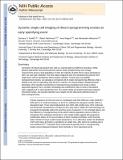Dynamic single cell imaging of direct reprogramming reveals an early specifying event
Author(s)
Smith, Zachary D.; Nachman, Iftach; Regev, Aviv; Meissner, Alexander
DownloadRegev_Dynamic single.pdf (3.171Mb)
OPEN_ACCESS_POLICY
Open Access Policy
Creative Commons Attribution-Noncommercial-Share Alike
Terms of use
Metadata
Show full item recordAbstract
The study of induced pluripotency often relies on experimental approaches that average measurements across a large population of cells, the majority of which do not become pluripotent. Here we used high-resolution, time-lapse imaging to trace the reprogramming process over 2 weeks from single mouse embryonic fibroblasts (MEFs) to pluripotency factor–positive colonies. This enabled us to calculate a normalized cell-of-origin reprogramming efficiency that takes into account only the initial MEFs that respond to form reprogrammed colonies rather than the larger number of final colonies. Furthermore, this retrospective analysis revealed that successfully reprogramming cells undergo a rapid shift in their proliferative rate that coincides with a reduction in cellular area. This event occurs as early as the first cell division and with similar kinetics in all cells that form induced pluripotent stem (iPS) cell colonies. These data contribute to the theoretical modeling of reprogramming and suggest that certain parts of the reprogramming process follow defined rather than stochastic steps.
Description
available in PMC 2010 November 1.
Date issued
2010-05Department
Massachusetts Institute of Technology. Department of BiologyJournal
Nature Biotechnology
Publisher
Nature Publishing Group
Citation
Smith, Zachary D et al. “Dynamic Single-cell Imaging of Direct Reprogramming Reveals an Early Specifying Event.” Nature Biotechnology 28.5 (2010): 521–526. Web.
Version: Author's final manuscript
ISSN
1087-0156
1546-1696